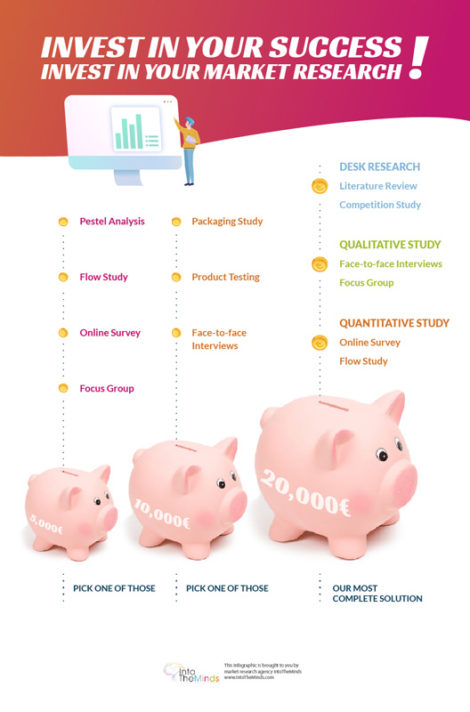
How to do market research? You will find the answers in this article, offered to you by the market research agency IntoTheMinds. Find here episode 1 and here episode 2. We completed this series of articles in 2018 with the creation of an online market research guide that you can access free of charge on our website. For any question, request or quote for market research in Belgium, France or elsewhere, do not hesitate to contact us. We are at your disposal, and we use all our expertise to help you, whatever the country concerned.
Summary
- A brief reminder of the first 2 parts
- PESTEL analysis
- Synthesis of the results of the market research
- Where to find the data for your market research
- How much does market research cost?
A reminder of the first 2 parts on conducting market research
The first two articles (see here the first article, and here the second) in our series on conducting market research, addressed the methodological part and focused on describing the analysis of general market trends, the review of supply (competition research) and demand (qualitative and quantitative research). At the end of this introductory course, it is now time to tackle the last part (the study of the environment) and the synthesis. We will conclude with the data and information sources, and give you an idea of the price of market research should you wish to have it done.
Step 4: Analysis of the environment
Your environment, that of your project, is made up of all the variables over which you have no control. Legal variables, political variables, environmental variables, all can positively or negatively influence your project and its chances of survival. However, you have no control over them.
The PESTEL analysis allows you to systematically analyse these variables and assess the potential impact on your project. This analysis requires first of all that you take a step back from the market, but also that you use external expertise. You cannot, by definition, evaluate or analyse what you do not know, and a major mistake would be to spend a day doing this analysis by yourself and think it is complete. Confront points of view, call on experts in your future sector of activity, interview suppliers and even competitors. Anything is possible and seeing a door close again at your request should not discourage you; on the contrary, it is only a foretaste of what will await you during your tribulations as an entrepreneur.
You will be able to find documentation about The PESTEL analysis on the Internet. A quick search will allow you to deepen your knowledge. However, you will find below an extract from a training course given by IntoTheMinds on the subject. This is one of our most popular online courses, viewed more than 250,000 times.
Step 5: Synthesis of the results of the market research
Analysing is all well and good, but we must also conclude it. The results of the preliminary research are intended to be summarised in an analysis called SWOT (Strengths – Weaknesses – Opportunities – Threats) which summarises – the strengths, weaknesses, opportunities and threats of your project.
If you wish to decide in a completely objective way, all you will have to do is assign a rating or score to each factor and sum up your strengths and weaknesses, opportunities and threats, to judge the criticality of your project.
We conclude this article with some practical information.
Where can you find the data to conduct your market research?
The search for existing data is called desk research. It consists in taking stock of what is available by collecting information published elsewhere. The most accessible sources of access, often at a lower cost, are:
- the press, magazines, books, and so on;
- specialised websites and discussion forums (for example, our blog provides a wide range of information every two days – our frequency of publication – as well as specific advice on how to carry out your market research and business plan). For example, consider consulting the specialised forums on LinkedIn (they are sometimes very active) which will also allow you to identify the most prominent people in a given sector or subject. Perhaps this will enable you to conduct interviews or obtain personalised feedback on your project (this is the qualitative research phase).
- sectoral, national and international studies and statistics carried out by specialised agencies. An impressive number of federations and professional associations exist (especially in Brussels) that collect data, aggregate statistics, and then make them available free of charge to members and individuals upon request. Enjoy it! If a professional association exists in your future sector of activity, meeting its leaders will also be an excellent opportunity to network and find candidates for your qualitative interviews or information for your competition study. Try to take advantage of all the synergies that are available to make your work easier.
- the proceedings of conferences;
- university theses and dissertations;
- scientific articles (which we recommend you search via Google’s excellent tool: http://scholar.google.com)
- financial databases.
The most commonly collected information by this type of research is:
- general market data: size in volume (number of units) and value (in € or another currency), growth rate (critical to judge the appeal of a market without forgetting the concept of market strata discussed at the beginning of this article), leading trends, market breakdown/segmentation, maturity level (consider the GPS market, for example, everyone has one today, and the market has changed from an equipment market to a replacement market, which influences its size), and so forth;
- the identification of the main actors and opinion leaders;
- the general economy of the sector: structure of profit margins, determinants of profitability, capital intensity, organisation of distribution channels, brand weight, and so on;
- the identification and qualification of competitors (direct and indirect: remember what we have written about the competition), nature of the offer (marketing mix), turnover, annual growth, financial health, seniority, brand image;
- regulations and standards to be respected: we insist that you professionally conduct this study. We see too many project leaders who fail, lose hope and sometimes their money because they have abandoned or neglected to take into account legal aspects. Remember that complying with legal standards and constraints has a cost and that if you ignore these costs, your profitability will be further affected.
- the state of the art and technological perspectives.
As simple as this desk research may seem, you will find that the location and accessibility of data remain the most complicated aspect of the research. And unfortunately, I don’t have a miracle solution. Some societal data are readily available and free of charge (for example, on the NSSO website for Belgium), others are subject to a fee; in the worst case, they are not available. In B2C, many behavioural data exist because some companies manage panels and trade their results. GfK, Ipsos, Nielsen can provide you with detailed data on consumption and consumption trends. However, these data are relatively expensive (sometimes several thousand euros), and it may not be unreasonable to subscribe to some specialised magazines that regularly publish extracts. Marketing Magazine, for example, monitors consumption data for specific product categories on several pages each month. These consumption data can also be found in specialised journals and monitoring can help you identify them. The salmon pages of Le Figaro (on subscription: www.lefigaro.fr) are a mine of data for those who know how to monitor their daily life over a long period. If you lack the courage, nothing prevents you from subscribing to our blog, through which we regularly publish results.
Finally (or to start with), once you have gained a first overview of your market by collecting the data, you will need to define a collection strategy to work efficiently and not be overwhelmed by unnecessary data. After a few days of intensive reading, relax and write down the indicators you want to collect and how you plan to get them. This exercise will require you, if you do not find the data you wish to, ask yourself about parallel ways to proceed, for example, by making an approximation using other variables that you know.
What is the cost of market research?
Here is another recurring question that inspired us to write a complete article that has become a reference on the Internet. If you decide to have specific steps carried out by an outside company, be aware that market research is worth the price you want to pay for it. It all depends on the nature of your project and the level of detail you will require. Everything will also depend on the professionalism of your interlocutor and his or her ability to respect the “rules”. There is nothing worse than a service provider taking methodological shortcuts to deliver only half the truth. Use the above information to guide your choice and understand the offer made to you, especially if it includes a qualitative analysis phase.

It’s up to you now. Work well! Feel free to contact us with any questions or comments to enrich the discussion and reflection of other readers.
Posted in Entrepreneurship, Marketing.